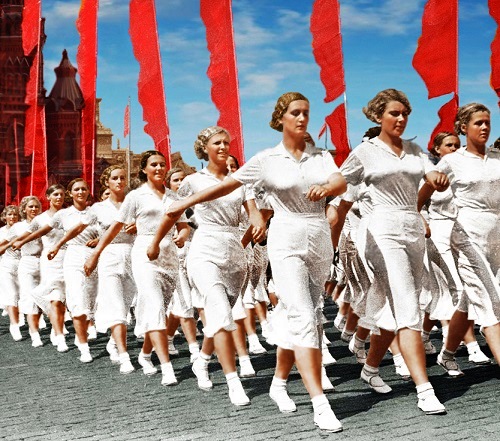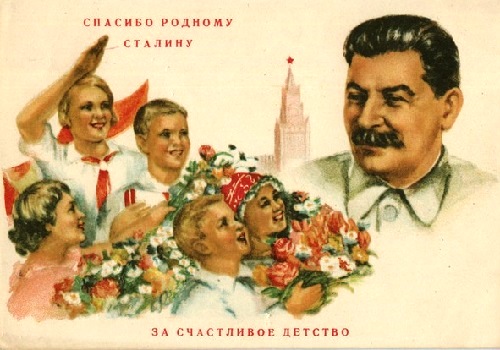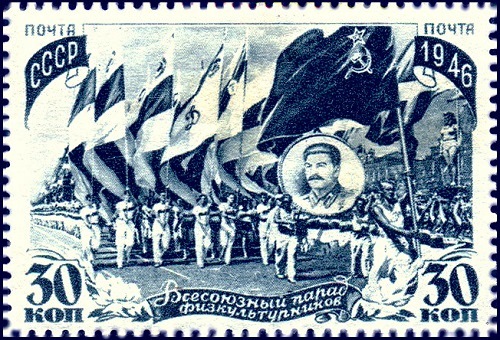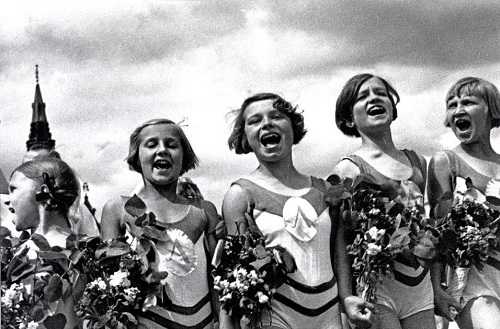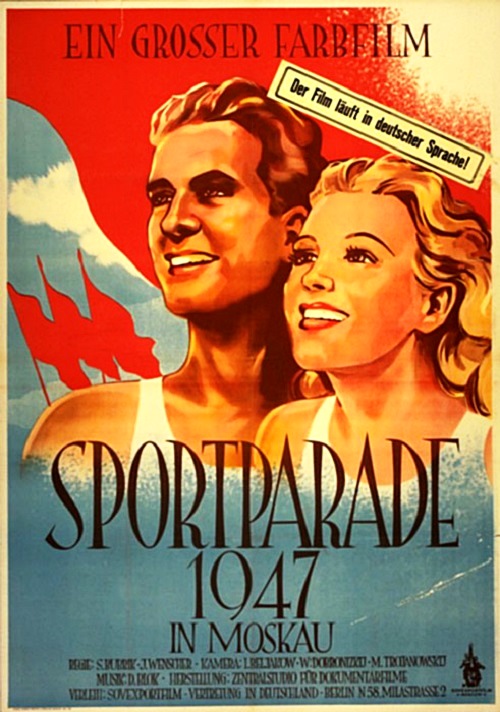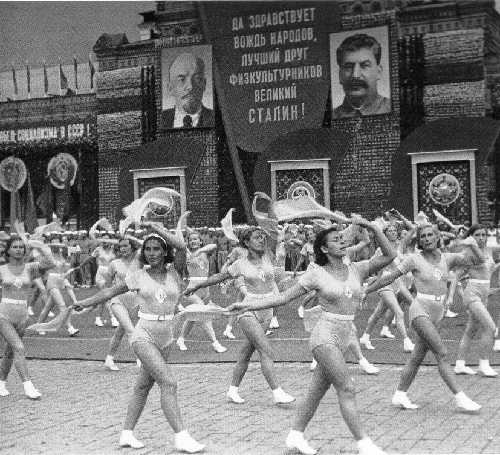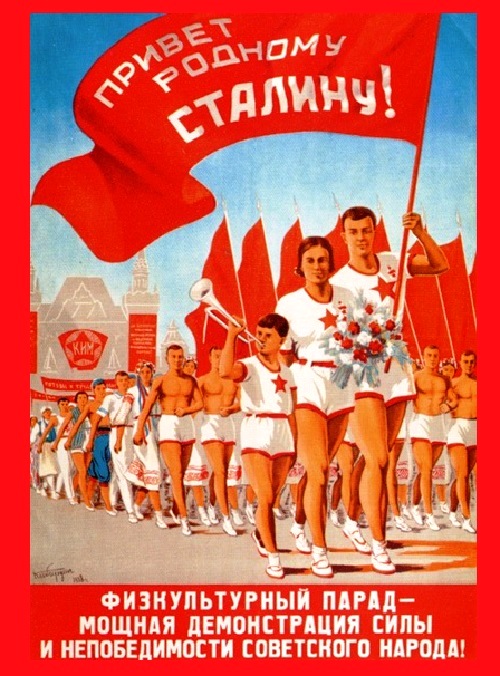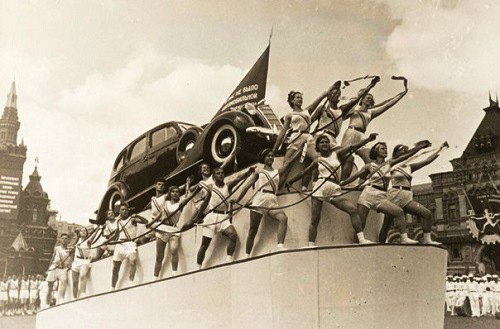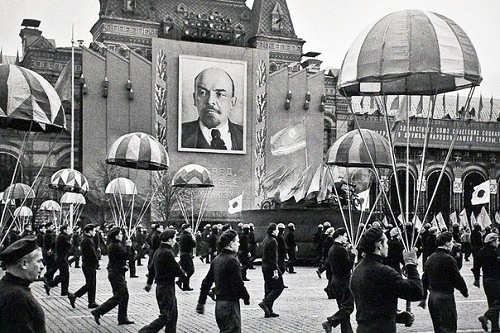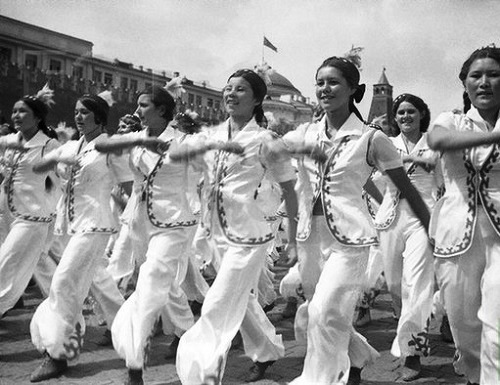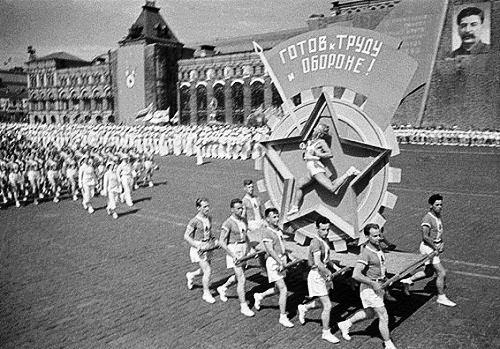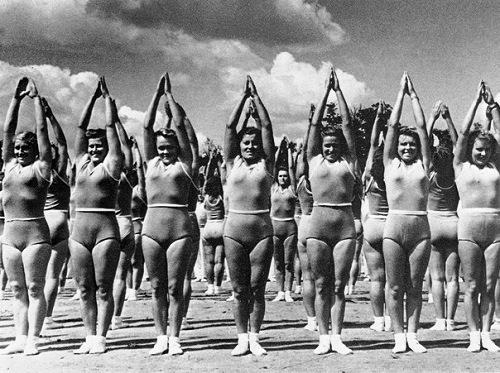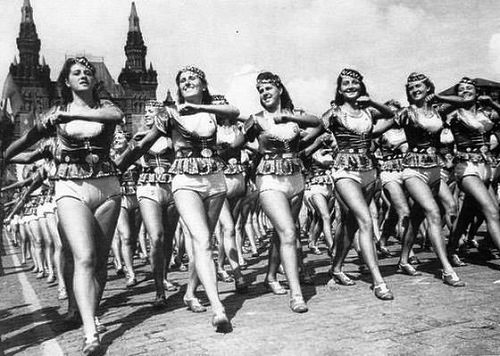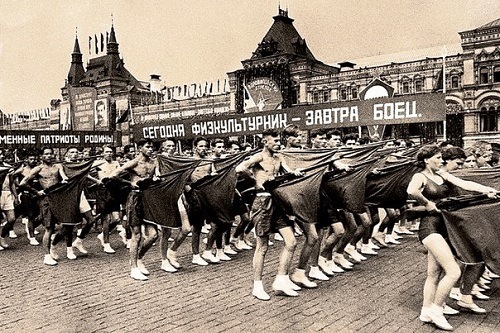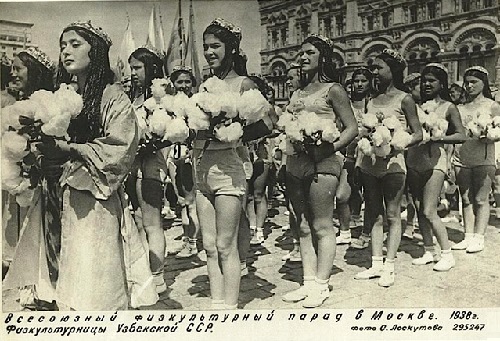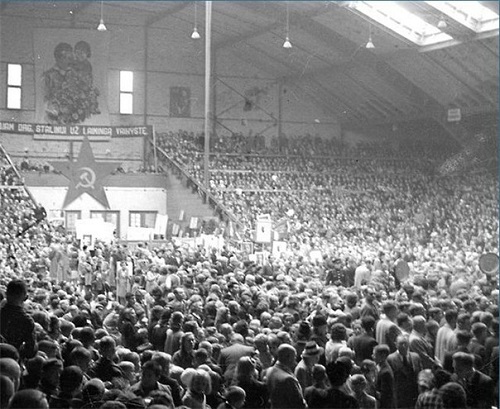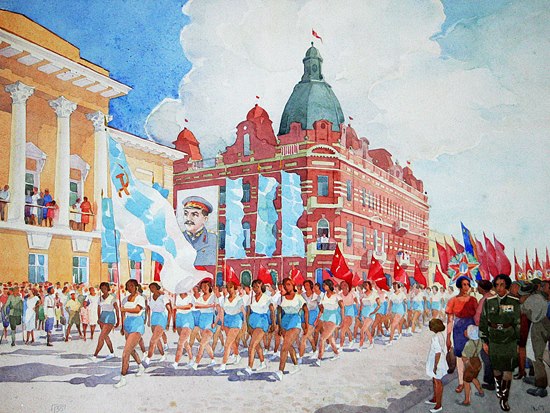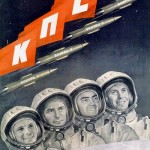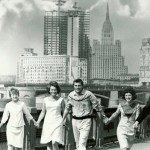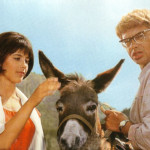Physical Culture Parades in USSR
Physical Culture Parades in USSR
“Streets – our brushes, squares – our palettes” – these words by Vladimir Mayakovsky come to mind when you look at archival photos of Physical Culture Parades in USSR. In 1919, the Red Square in Moscow hosted the first parade of athletes and teams of Vsevobuch (system of compulsory military training). The most grandiose parades were held in the capital of the Soviet Union – Moscow. Parades were also held in several other cities of the USSR. In particular, in 1927 in Barnaul the celebration of the 10th anniversary of the October Revolution, with the parade of athletes. Since 1931, the parades have been held annually, first in Moscow and Leningrad, and then in the other cities of the USSR. In 1935, at the parade of athletes in Moscow, Stalin was named “the best friend of the pioneers,” and in 1936 at the athletes parade in Moscow was first introduced the slogan “Thank you Comrade Stalin for our happy childhood!”.
Thank you Comrade Stalin for our happy childhood! For the first time this phrase sounded in 1936 as a slogan, which was carried by participants in sports parade on Red Square. Subsequently, this expression sounded each time, when there were the topic “Stalin and children”, “Stalin and young people”, and so on. September 23, 1937 in the newspaper “Pravda” was published an editorial titled “Happy Children of Stalin era,” where were the words, “Thank you Comrade Stalin for our happy childhood.” This publication (editorial in “Pravda” expressed the official position of the government) finally cemented the phrase in the political use of the time.
In the All-Union sports parade participated athletes of all Soviet republics. Since 1939 the parade was held in conjunction with the All-Union Day of Athlete. The first post-war parade of athletes (and the last on the Red Square) was held August 12, 1945. It was devoted to the Victory in the World War II. It was attended by 25 thousand participants of the 16 Soviet republics. In the sport parade were 22 performances, which lasted 4 hours 20 minutes. The color version of documentary chronicle “All-Union parade of athletes 12 August 1945” (directed by Vasily Belyaev, CSDF, 1945) was shown on TV Culture May 9, 2011.
In the 1940s, costumes and songs for the Parade of athletes on Red Square, created a well-known theater artist Fedor Fedorovich Fedorov. The last parade of athletes was held in 1954.
Physical education and sports in the 1930s, have become a hot topic of Soviet art and A. N. Samokhvalov was here one of the recognized leaders. The artist himself confessed that physical culture was for him “the joy of life, the joy that accumulates the potential to overcome the difficulties in the struggle to build a new life.” “I loved it as gymnastics is healthy human culture, active and cheerful”
Sportsman’s Day, more than any other art form conveys the poetry of youth and strength. What kind of art can compete with these holidays in strength? Even the all-powerful movie failed to fix and a small fraction their immense power and beauty. Is it because they attracted all by the beauty of youth, with its optimism, with its focus on the future, with its hopes, self-confidence, boldness, desire to win? We probably loved these holidays, because they inspired each of us with youthful brilliance that infused joy in our hearts.
Is it possible to remain indifferent, watching in the early morning the living stream of columns of athletes dressed in festive form and carrying rolled up banners? How not to admire the shimmering elastic muscles of tanned torsos of young men going to a holiday, glitter of girls’ eyes? Is it possible to remain indifferent to the green, carefully prepared, a huge plane soft felt carpet, festively clean, untouched in the anticipation of the upcoming solemn march.
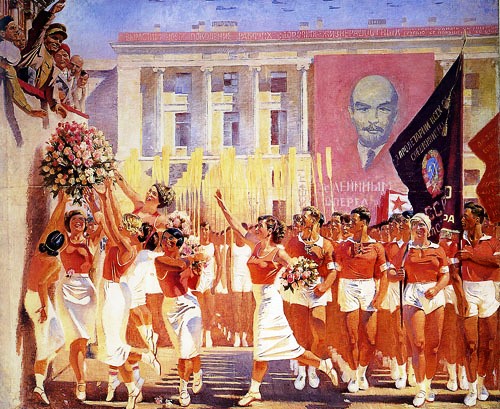
Kirov greets the parade of athletes. 1935. AN Samohvalov. Canvas, oil. 306 × 373 cm. The State Russian Museum, St. Petersburg
And those who came to watch experienced the joy in the contemplation of the youth parade. Everything merges into a single, great pre-holiday excitement of the whole people, common for spectators and participants. Yet there was, gleaming in the morning sun glare tools, snow-white mass combined with orchestra, not yet cut through the festive air “sparkling” sounds of golden fanfare and solemn atmosphere has prevailed.
The success of sports events was due to a very great role of directors and artists. In the 30-40s they fruitfully worked on the creation of the climax, the final compositions to put a spectacular point in performances. Here – sporty girls appeared in the opened cotton box, crowning the whole white gold flowerbed, there – suddenly appeared a red outline of a star, or labels, or a fountain, or a vase, made of athletes – these and innumerable other inventions, caused the emotional approval of the crowd.
Names of Igor Moiseyev, for the first time to decorate Red square with living birches created this unexpected area of native wildlife in the performance of the Belarusian delegation; or Kasyan Goleizovsky, who invented a system of “in-line motion”, then firm place in the gymnastics elements, and many, many other names that have enriched massive celebration of their original fiction, entered firmly the history of sports parades. Leaders of sports performances contributed to the flourishing of festivals, deeply aware of the importance of decoration, they helped develop it. Commonwealth of directors with the designers gave positive results.
Often, the basic solution came from the artists. Often they belonged to the idea of the image of the whole performance as a whole. And it is quite natural, since the parade was more designed for visual perception, rather than a demonstration of high sports achievements, and therefore was closer to the artist than coach of athletes. The artist often and rightfully enjoyed a commanding position and determined the whole structure and nature of the performance. By the way, it is no coincidence that most of the design of these events created theatrical artists. It is no coincidence that it was they who had brought a valuable theatrical tradition of subordinating creativity to the general idea, the ability to work in a team and find a solution, that was consistent with all other components, it is they who knew the laws of action, created the most striking, original and successful shaped design that developed this important side of mass holidays.
Directing thinking of theater artists became guarantee measures of artistry in the supply of content of presentation. The desire to hit with the suddenness of the effect, the original decision was to prevail in the creative designs of parades. The relatively limited opportunities in physical performances of artists constantly forced to seek and invent more new design tricks. So a new reception was instantaneous transformation of gymnastic apparatus. So, gymnastic Mace turned into a drop-down box or cotton, or head of a sunflower, or poppy; Gymnastic pole was transformed into a giant golden spike, flag or paddle with colored blades, etc. All kinds of scarves, pennants, flags, created their sudden appearance of color splashes and various ornamental patterns -.. all this has been the subject of careful study, a generous use and durable became part of sports props. Year by year, perfected ingenuity. Previous findings ceased to satisfy. The transformation has gone much further, connecting with other elements of performances – music, rhythm, etc…
The turning point in music and in the design created a double effect, it was amplified by the dance and made necessary and justified to paint cheerful performances of the young generation of the country of the Soviets. Using such techniques, the artists determined the success of the passage of the columns in a march-parade. They have created, for example, by means of a minor element in the hands of each participant grand, flashy color picture. To this was added the appropriate background. Thus, the paddle against the blue horizontal panels and the white sails created a picture of the sea, and ears-clubs or bars on a background of golden panels conjured up images of cornfields. Huge, sparkling volume figures emphasized agitation and semantic aspect of these performances.
Since 1946, the “Dynamo” stadium, and then the stadium named after Lenin in the Luzhniki became regular and traditional places of mass physical culture festivals. The very architecture of the stadium, a circular viewing of the spectacle from all points of the stadium space, top view, created thanks to the steep angle stands – all this made radically breaking canonical processing techniques.
Performances of athletes who have completed the form, complete fusion of all components – content, music, movement and design, included in the memory forever. Is it possible to forget the short performance of athletes of the Karelian republic with skis? Whole and expressive, it conveyed the nature of the region (without naturalistic illustration) and vividly spoke of the beauty of skiing, the courage of athletes.
Superbly designed performance of Lithuanian athletes with basketballs, which began with individual exercises and finished with a huge firework ball thrown into suddenly appeared basketball net. Everything there had been thought out by artist and athletic director. Ornamental weaving of different colored balls, their resurfacing, ornamental component rapidly, in conjunction with the music created a whole picture, a song about the Baltic republics and the exercise style of favorite sports helped to feel unique national flavor.
Unforgettable were gently pouring sounds of Russian song “Don’t sew me, mother, red sundress”, talented and finely designed and orchestrated by the composer Roitman, served to create a memorable speech of the Russian Federation column in 1945. It was as poetic, as an expression of the soul and essence of Russian girl with her captivating, modest grace for whom the audience felt deep emotion, this performance captivated everyone.
Unforgettable were the tight columns of trade unions which found great and simple solution of simple movement of the raised hands, causing the association with the picture of ripening fields and running through them waves. Or instantaneous transformation of two thousand columns of labor reserves of cornflower field in scarlet. This caused a single gasp of surprise of all present, and only after a pause, the stadium burst with applause. The combination of changes of costumes of sporty girls with a sharp break in the music (invented by composer Novikov) created the basis for the success of strong and solid performances.
There were many more fortunate decisions: performances of athletes forming beautiful concentric circles – in the traditional performances of students of the Moscow Institute of Physical Education; and the brilliant performances on the gymnasts equipment by Lesgaft Leningrad Institute and much, much more. Everywhere artists, amicably collaborated with composers, film directors and athletes, constantly enriching the performances, making the effectiveness of the elements of color.
Old dream of those involved in the artistic side of sports parades, to organize sport parades in the evening under floodlights, with the use of light elements in rhythmic gymnastics. Completely this idea for a long time could not be implemented, despite the obvious advantages of such an artistic decision. However, in the solemn day of the closing of the VI World Festival of Youth artists finally managed to realize this dream.
Gymnastic exercises with flags of fluorescent fabric by 25 thousand athletes, highlighted the special equipment and the very keynote performance at the stadium of two thousand women with clubs, glowing sparklers – all confirmed as innumerable opportunities of use such a powerful tool as the light.
Future parades, of course, relied on the experience of the USSR – planned in such a way that they would have started in a relatively light time of the day, at the turn of night time and have ended late at night, so that artists and directors could use an unusually rich for its artistic features spectacular element – light.
Among the most interesting features was a massive (1,5 – 3000 participants) performance in a compact close rows, which opened many new emotional and artistic opportunities (artists Ladur and Beletsky). The unique invention of “Belarusian vases” (Gubanov). This name was given to the high circular structure on which floors simultaneously worked dense ranks of gymnasts, performing specific in-line movement (Goleyzovsky), because of what “the vase” seemed to change shape every second. For the first time, “vase” appeared in a performance at the celebration of the Belorussian SSR athletes in 1946.
Physical Culture Parades in USSR
Among the magnificent masters, organizers, directors and inventors who have created massive sports events – parades were M.D. Segal, dedicated his life to the establishment and development of artistic genre in sports-mass festivals, and his colleagues – Tiverovsky, Osipov, Gubanov, Glinternik, Sery, Beletsky, and others; artists Ladur, Rublev, Khrapovitsky, Romas. At various times, these enthusiasts have built and strengthened the foundation and erected the height of the genre, adding to it their ideas and inventions.
The post was created on the autobiography-book of Boris Knoblock, 1986
